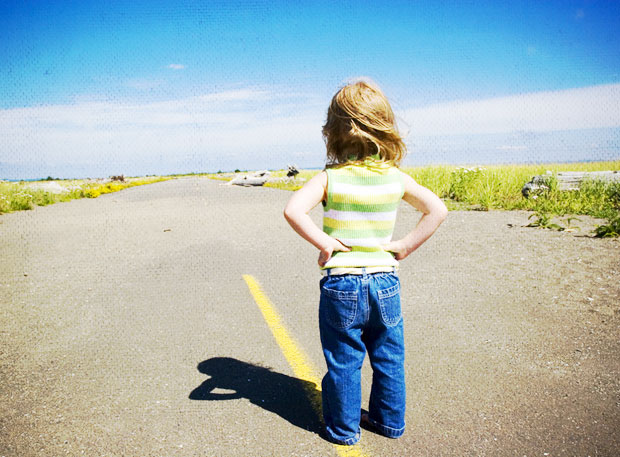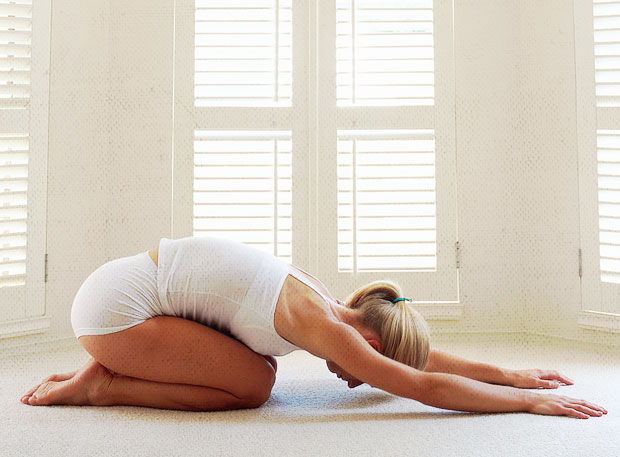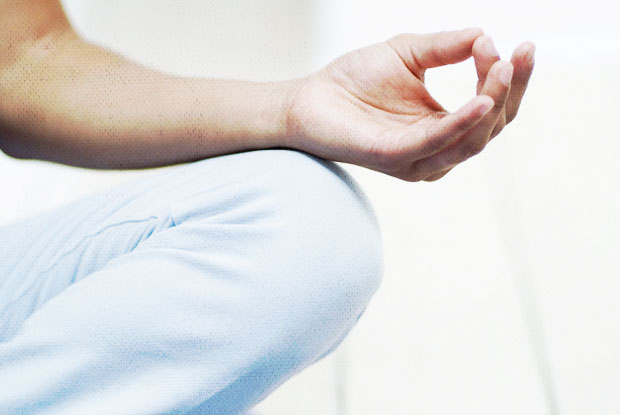
When I injured my right knee during an overly-intense vinyasa class last September, it was a huge wake-up call. My ambitions, ideas, and the habits surrounding my practice were suddenly brought to a grinding halt. I was unexpectedly faced with big, difficult questions, like how could I continue doing what I loved, while maintaining a healthy relationship with my physical self? What kind of yoga should I be doing to heal? Where would my practice go now? And, how would my experience benefit me and my students?
As a do-er with a lot of drive, I naturally wanted to figure everything out immediately. What was the lesson? And what was the plan? But life, of course, is never quite that simple. Lessons and healing are complex, take time, and are often filled with ups and downs. Throughout my recovery I’ve had to accept the fact that there is just no clear-cut path, and that each day will be new and unique, with its own obstacles.
…Some lessons—often, the ones we need to learn the most—are the ones we refuse to see, no matter how many times they hit us over the head.
And some lessons—often, the ones we need to learn the most—are the ones we refuse to see, no matter how many times they hit us over the head. For me, this lesson was to evolve the approach to my yoga practice: to shift from vinyasa flow yoga as my singular form of exercise and release, and to embrace new styles and alternate forms of exercise.
Being totally in love with my daily vinyasa practice, this meant a complete one-eighty for me—and not one that I wanted to take. Vinyasa, by nature, is physically taxing on the body. It’s very essence—flowing from one pose to another in a fluid, steady pace—is a cardiovascular workout—and the only one I was getting prior to my injury. By dancing the vinyasa dance, your heart rate rises, you begin to sweat and detoxify the body, and your muscles grow warm and supple, allowing your capacity for stretching and release to deepen.
In the beginning, my injury prevented me from doing much of anything, let alone vinyasa. I had a serious limp for two months, and as my muscles grew weaker, I practiced restorative, yin, and super gentle yoga. I was very attentive and kind to myself, and slowly—with this new approach as well as physical therapy—my body began to recover.

But impatient as I was, I tried to return to vinyasa as soon as I could, even though there were clear indications that my body wasn’t ready for it. In my weakened, off-balance state, a vinyasa class was simply too intense. My knee, even on its better days, would audibly “grind” during simple transitions, and feel tender and achy afterward.
Convinced my former relationship with vinyasa would return, I pressed on, determined not to “let go” of the yoga I knew and loved. It wasn’t until other injuries—little pulls, aches, and pains in my misaligned right leg and hip—began to show up that I realized something needed to change. Vinyasa was no longer serving me, and was actually preventing my recovery.
This was a huge pill to swallow.
At first, I was stifled. I tried simpler hatha classes, but while they left me feeling limber, the deep sense of release wasn’t there. My practice began to dwindle, becoming less frequent and shorter in length. I noticed my muscles growing tighter and any yoga becoming more challenging. I was afraid of what was happening to me, yet afraid of practicing! I didn’t want to grow weaker, but I didn’t want to re-injure myself. I felt trapped and depressed.
…I realized something needed to change. Vinyasa was no longer serving me, and was actually preventing my recovery.
And then, one day, out of curiosity or desperation, I decided to try a Kundalini class by Kia Miller on Yogaglo. Having tried Kundalini in the past, I’d found its long, repetitive motions, called ‘kriyas’, to be monotonous and boring. I’m the kind of yogi that likes to get lost in complicated movements, so doing the same thing, over and over for three minutes straight, is not all that enticing to me. But on this particular day, I just needed to move. And only 45 minutes later, I was buzzing with energy, light and vibrancy—the movements had been so simple, so uncomplicated. How could I feel so good?
That’s when it hit me: I had been missing cardio! With my yoga practice shifting to an ever-slower, more cautious pace, I had been—for months—unable to lift my heart rate. The fire in my belly had been snuffed out, and my prana (life force, or, in Chinese medicine, Qi) was beyond stagnant. The kundalini kriyas, as basic as they were, made me work! They raked the coals and flushed my system, clearing space in my mind and leaving me bouncing and zipping about like I’d just finished a power yoga marathon!
This tiny revelation was just what I needed to shed light on a new pathway for my recovery: to rebuild my strength, heal my body, and stoke my inner fire, I needed to incorporate cardio into my life, alongside a gentle hatha practice. Then, perhaps with time and healing, I might return to a vinyasa flow, embracing it with a new perspective. But knowing how to rebuild without harming my knee was encouraging and exciting!

The next day, I did what I hadn’t done in years: I went to the gym! Since walking felt like it improved my knee, I decided to give the elliptical machine a chance: only twenty heart-fluttering minutes later, and I was walking on clouds. I felt so good, I decided to stay awhile and lift some weights, while I was at it!
There have been many low points in this journey of healing for me, and looking back, I can now see a direct correlation between low pranic flow and depression. Because of my desk job, my life is mostly sedentary, and the healing process required more time than I’d like to admit with my tush planted on the couch. All of that sitting and feeling sorry for myself left my prana—my heart’s energy—flat and listless. It had never really occurred to me that cardio, be it running up and down stairs for fifteen minutes or a creative vinyasa class, was the aspect of my practice that kept me humming and vivacious.

As I re-envision my physical relationship with yoga and turn more toward the health of my heart and soul, I realize that this lesson is much more vast than just broadening my view of exercise and technique. It, too, makes me see that when we believe there is only one right way for us, and we cling too firmly to what we love, we will inevitably be asked to reconfigure our approach. We, and the world around us, are in constant flux, and what may work brilliantly today may be insufficient tomorrow. It’s an old lesson, but one that I feel more deeply than ever as my fixed opinions and preferences are challenged. If we can learn to hold still in our present situation, truly feel what it is we need now, we just may realize that what we thought was the “only way” is really just a doorway to a more beautiful and fulfilling route. One that may ultimately lead to healing us outside, and in.

I love this post Raeanne – and congratulations on writing it, as I know it’s been shaping in your mind for months.
This part: “I was afraid of what was happening to me, yet afraid of practicing! I didn’t want to grow weaker, but I didn’t want to re-injure myself. I felt trapped and depressed.” – this is just how I felt when I was injured in 2007. Not understanding how my body was working, what was contributing to my pain, and exercising in ways that only reminded me of my limitations and pain left me feeling trapped as well. It is such a hard place to be. Patience with myself has never been one of my virtues! ;-) But when I finally learned a few of the major tenets of yoga – listening to your body, approaching it with play and humor – I began to think differently about myself and everything else in my life and it gave me room to evolve.
And this part, when you wrote, “…when we believe there is only one right way for us, and we cling too firmly to what we love, we will inevitably be asked to reconfigure our approach.” What a rich, important revelation. Thank you so much for sharing this too me. I think when we hold too tightly to one thing, we close our ability to see what other opportunities are before us. The trick is to.. oh my gosh I’m going quote an 80’s song (snort snort)… hold on loosely but don’t let go…. haha! But true, right?
Thanks for this great post!
Thanks so much, Jen… as always, your insights help deepen what I’ve been learning and reflect the same lessons but with different perspective. I hadn’t realized you’d gone through a similar healing experience, and that I’ve resonated with your memories of healing gives me encouragement that I’m on the right track in my own journey. Thank you, so much, for always brightening the light!
This post really resonates with me! I’m going through the same kind of “withdrawal” but I’m also really trying to take care of myself and pay attention to limits. My experiences with injuries have encouraged me to delve deeper into anatomy and biomechanics, too. And it’s funny about the elliptical…my parallel is the pool because it’s the only place where my foot doesn’t bother me. So, I’m learning how to swim better!
Awesome! Great advice about the pool. I’m working on an article about how to maintain your practice when you can’t do vinyasa, and I plan to include something about swimming… it really is the best no-impact exercise out there. Thanks for contributing — I’m so glad this resonated with you :-)